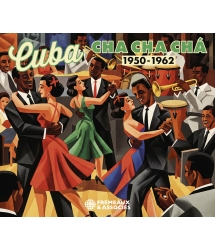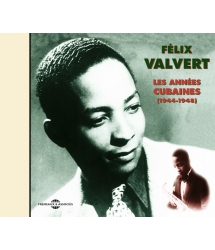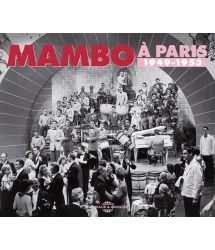- Our Catalog
- Philosophy
- Philosophers of the 20th century and today
- History of Philosophy (PUF)
- Counter-History and Brief Encyclopedia by Michel Onfray
- The philosophical work explained by Luc Ferry
- Ancient thought
- Thinkers of yesterday as seen by the philosophers of today
- Historical philosophical texts interpreted by great actors
- History
- Books (in French)
- Social science
- Historical words
- Audiobooks & Literature
- Our Catalog
- Jazz
- Blues
- Rock - Country - Cajun
- French song
- World music
- Africa
- France
- Québec / Canada
- Hawaï
- West Indies
- Caribbean
- Cuba & Afro-cubain
- Mexico
- South America
- Tango
- Brazil
- Tzigane / Gypsy
- Fado / Portugal
- Flamenco / Spain
- Yiddish / Israel
- China
- Tibet / Nepal
- Asia
- Indian Ocean / Madagascar
- Japan
- Indonesia
- Oceania
- India
- Bangladesh
- USSR / Communist songs
- World music / Miscellaneous
- Classical music
- Composers - Movie Soundtracks
- Sounds of nature
- Our Catalog
- Youth
- Philosophy
- News
- How to order ?
- Receive the catalog
- Manifesto
- Dictionnary











- Our Catalog
- Philosophy
- Philosophers of the 20th century and today
- History of Philosophy (PUF)
- Counter-History and Brief Encyclopedia by Michel Onfray
- The philosophical work explained by Luc Ferry
- Ancient thought
- Thinkers of yesterday as seen by the philosophers of today
- Historical philosophical texts interpreted by great actors
- History
- Books (in French)
- Social science
- Historical words
- Audiobooks & Literature
- Our Catalog
- Jazz
- Blues
- Rock - Country - Cajun
- French song
- World music
- Africa
- France
- Québec / Canada
- Hawaï
- West Indies
- Caribbean
- Cuba & Afro-cubain
- Mexico
- South America
- Tango
- Brazil
- Tzigane / Gypsy
- Fado / Portugal
- Flamenco / Spain
- Yiddish / Israel
- China
- Tibet / Nepal
- Asia
- Indian Ocean / Madagascar
- Japan
- Indonesia
- Oceania
- India
- Bangladesh
- USSR / Communist songs
- World music / Miscellaneous
- Classical music
- Composers - Movie Soundtracks
- Sounds of nature
- Our Catalog
- Youth
- Philosophy
- News
- How to order ?
- Receive the catalog
- Manifesto
- Dictionnary
RICO' S CREOL BAND 1947 - 1951
Ref.: FA5055
EAN : 3700368480618
Artistic Direction : ALAIN BOULANGER
Label : Frémeaux & Associés
Total duration of the pack : 1 hours 42 minutes
Nbre. CD : 2
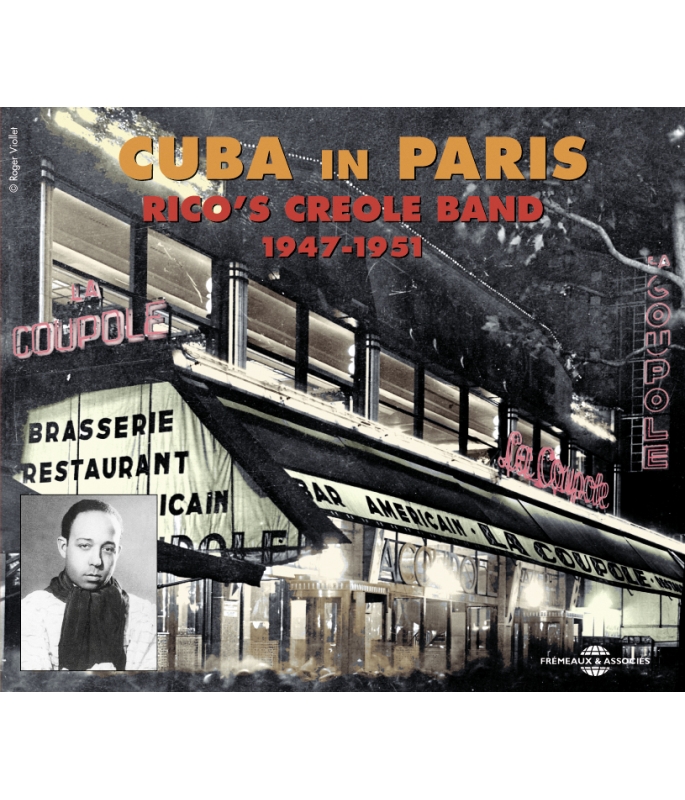
RICO' S CREOL BAND 1947 - 1951
RICO' S CREOL BAND 1947 - 1951
(2-CD set) The Cuban Rico’s Creole band was behind the grand years of Parisian world music and entertained the clientele of La Coupole for decades. Alain Boulanger presents the exotic sound heritage of post-war Paris. Includes a 28 page booklet with both French and English notes.

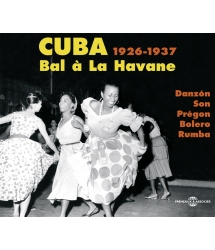
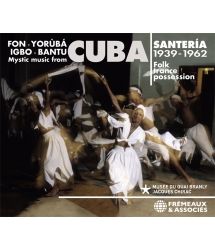
-
PisteTitleMain artistAutorDurationRegistered in
-
1NAGUERICO S CREOLE BAND00:02:361947
-
2BIM BAM BUMRICO S CREOLE BAND00:02:311947
-
3MARIA DE BAHIARICO S CREOLE BANDPAUL MISRAKI00:02:281947
-
4DINORAHRICO S CREOLE BANDBENEDITO LACERDA00:02:521947
-
5TRES PALABRASRICO S CREOLE BAND00:02:381947
-
6LA MUCHICARICO S CREOLE BANDM BATTISTELLI00:02:531947
-
7TU FELICIDADRICO S CREOLE BAND00:03:021947
-
8BABALOURICO S CREOLE BAND00:03:161947
-
9MANUELITA PALABRAS DE MUJERRICO S CREOLE BAND00:02:471947
-
10BAILANDO LA GUARACHARICO S CREOLE BAND00:02:581947
-
11UN SOIR DE CARNAVALRICO S CREOLE BANDJACQUES LARUE00:02:461948
-
12LA ULTIMA NOCHERICO S CREOLE BAND00:02:421948
-
13LE DANSEUR DU PERROQUETRICO S CREOLE BAND00:02:261948
-
14ANGELITOS NEGROSRICO S CREOLE BANDA F BLANCO00:03:121948
-
15SOMOS DIFFERENTESRICO S CREOLE BAND00:03:011948
-
16QUIEREME MUCHORICO S CREOLE BAND00:02:481948
-
17LA OLA MARINARICO S CREOLE BAND00:02:491948
-
18QUIZAS QUIZAS QUIZASRICO S CREOLE BAND00:02:471948
-
PisteTitleMain artistAutorDurationRegistered in
-
1COLIBRIRICO S CREOLE BAND00:02:381948
-
2SABROSURARICO S CREOLE BAND00:02:381949
-
3UN POQUITO DE TU AMORRICO S CREOLE BAND00:03:021949
-
4MARIA BONITA REVOIR PARISRICO S CREOLE BAND00:02:371949
-
5EL CUMBANCHERORICO S CREOLE BAND00:02:531949
-
6BA TU CA DARICO S CREOLE BAND00:03:141950
-
7LUNA LUNERARICO S CREOLE BAND00:03:191950
-
8MAGDALENARICO S CREOLE BAND00:03:181950
-
9NAO ESTARICO S CREOLE BANDA TORRE00:02:521950
-
10LA TELEVISIONRICO S CREOLE BANDMENENDEZ J CARBO00:03:001950
-
11LA MUCURARICO S CREOLE BAND00:02:431950
-
12MR LE CONSUL A CURITYBARICO S CREOLE BANDM HERAL00:02:261950
-
13LA FLEUR DE TES CHEVEUXRICO S CREOLE BAND00:03:021951
-
14SE ACABORICO S CREOLE BAND00:02:561951
-
15A MARIE GALANTERICO S CREOLE BAND00:03:081951
-
16DOS GARDENIASRICO S CREOLE BAND00:03:151951
-
17TUMBARICO S CREOLE BAND00:02:411951
-
18PAJARITORICO S CREOLE BAND00:02:361951
CUBA IN PARIS
CUBA IN PARIS
RICO’S CREOLE BAND 1947-1951
Rico's Creole Band
Les années d'après guerre
1947-1951
Nous évoquerons ici les activités après guerre 1947-1951, du talentueux flûtiste, clarinettiste, saxophoniste, compositeur et directeur d’orchestre Filiberto ou Hériberto – ces deux prénoms lui sont indifférement attribués –, RICO e IZQUIERDO. Présent dans notre pays depuis la fin des années 20, RICO, qui au début de la deuxième guerre mondiale s’est réfugié tout d’abord en Espagne, puis dans son île natale, Cuba, revient dès la paix rétablie en France et y reprend dès 1946 une intense activité musicale. Le début de celle-ci, encore enregistrée sur disques 78 tours, est l’objet de cette réédition. Il nous faut, même si ce ne sera que d’une façon assez succinte, présenter notre musicien aux lecteurs de ce livret. Né à La Havane aux alentours des années 1910, Filiberto RICO reçoit une formation musicale des plus classique, il effectue de brillantes études au Conservatoire de cette ville, obtient vers l’âge de 15 ans un premier prix de flûte et intègre alors l’Orchestre Philharmonique de la capitale cubaine. Arrivé en Europe en compagnie de son père, Isidro, qui lui aussi jouait de la clarinette, mais en amateur pourrait-on dire, vers 1926, RICO rejoint comme d’ailleurs la plupart des musiciens cubains qui s’y produisaient à cette époque, une formation de jazz. Il se produit en France mais surtout dans les pays scandinaves, on le trouve, par exemple, dans la formation THE JACKSON RHYTHM KINGS, en 1927 à Copenhague où il joue du saxophone alto et de la flûte. De retour à Paris vers 1928, il fait partie de l’orchestre qui se produit au dancing La Jungle à Montparnasse, orchestre de Jazz qui comprenait un grand nombre de musiciens cubains, ce qui explique qu’entre Fox-Trot, Charlestons et Shimmies et ce pour la première fois en France, on pouvait entendre quelques Sones, Danzones et Rumbas.
Filiberto RICO est aux côté des frères BARRETO, CASTELLANOS, d’Oscar CALLE, Jose RIESTRA, Fermin JOVA... un des premiers pionniers de la musique cubaine dans notre pays. Il fait partie de la plupart des premières formations cubaines qui se produisent et enregistrent dès le début des années 1930 en France de la musique typique de leur île; la Orquesta Tipica Cubana dirigée par le compositeur Moise SIMONS, l’orchestre du guitariste Emilio DON BARRETO dont l’immense succès au Melody’s Bar à Pigalle en 1932 a été le point de départ d’un extraordinaire engouement, qui ne s’est plus jamais démenti depuis, dans notre pays pour la musique cubaine. RICO quitte assez rapidement la formation de DON BARRETO pour prendre la tête, définitivement, de celle qui se produit à La Coupole de Montparnasse et qui prend alors le nom de RICO’S CREOLE BAND. Il sera le directeur de cette prestigieuse formation, un des orchestres de musique cubaine des plus célèbres en France et dans toute l’Europe, pendant plus de trente ans. Le RICO’S CREOLE BAND enregistre au cours de la décennie 1930-1940, sous son nom pour la marque GRAMOPHONE et sous divers pseudonymes pour les marques ODEON, PATHE ou SEFONO un nombre considérable de disques sur lesquels on peut entendre toute la palette des rythmes cubains alors en vogue : sones, rumbas, boléros, congas... La guerre contraint Filiberto à se réfugier en Espagne puis à regagner CUBA. Ses derniers enregistrements parisiens datent de 1941. De retour dans notre pays après une absence d’environ cinq ans, fin 1946, RICO reprend immédiatement ses activités artistiques et le chemin des studios d’enregistrements dès le mois de Mars 1947.
Il a pour ces séances d’enregistrements monté une nouvelle et imposante formation – lors de ses prestations dans les cabarets et dancings où il se produit celle-ci est plus restreinte, au sein de laquelle on trouve aux côtés de quelques musiciens français toute une pléiade d’excellents artistes cubains. Nous pouvons citer Luis GODY, pianiste d’exception, ancien membre du célèbre TRIO CUBAIN, Fermin Lorenzo JOVA, contrebassiste, chanteur à l’occasion, un des pionniers de la musique cubaine en France, Antonio PICALLO, pianiste à ses heures, mais surtout chanteur fantaisiste et meneur de revue, un autre pionnier des rythmes cubains dans notre pays : Pedro LUGO MACHIN, frère du célèbrissime Antonio MACHIN, trompettiste talentueux jouant dans la plus pure tradition cubaine et qui si lorsqu’il chante ne nous fait pas oublier son illustre frère, interprète néanmoins de façon fort agréable boléros et guarachas, Alvaro de la TORRE “ALVARITO” extraordinaire bongosero qui aura bientôt sa propre formation. On trouve encore dans l’orchestre de Filiberto RICO les saxophonistes Piccolino JUNCO et José BANDERA, le batteur MACHADITO, Aldo JOVA fils de Fermín Lorenzo, qui à cette époque jouait des instruments rythmiques typiquement cubains, guïro et maracas et est devenu depuis un pianiste de première force au tempo impeccable, ces derniers musiciens tous de nationalité cubaine eux aussi. Quelques interprètes français et espagnols complètent la formation, citons Emilio ARMENGOL violoniste également chanteur et chef d’orchestre, les trompettistes Adrien TERME et BESSON, l’excellent guitariste antillais Vincent RICLER que nous pouvons entendre exécuter de très bons solos dans Nague et Dinorah. Enfin RICO recrute dès son retour de Cuba d’où elle vient de se retremper aux sources de la musique Afro-Cubaine, la plus grande chanteuse de musique typique qui se soit produite de façon quasi permanente dans notre pays, et ce depuis le début des années 30, Joaquina “Chiquita” SERRANO, extraordinaire interprète des rythmes de Cuba, elle donne dès son intégration dans le RICO’S CREOLE BAND d’après guerre (elle y a bien évidemment déjà chanté dans les années 30), une impulsion nouvelle à celui-ci, grâce à une tonalité différente de celle des chanteuses françaises : YANILOU, Doris MARNIER ou Simone ALMA, qui un temps en ont fait partie.
C’est cette formation, dont la composition varie toutefois de façon notable au gré des sessions d’enregistrements, que nous pouvons écouter dans certains morceaux de cette réédition. Le RICO’S CREOLE BAND enregistre intensivement pour la marque GRAMOPHONE-LA VOIX DE SON MAITRE durant les années 1947-1951, on dénombre une soixantaine de faces gravées au cours de cette période à raison de 4 à 5 séances par an. A cette même époque RICO se produit à la tête d’une formation moins étoffée dans différents cabarets et dancings parisiens, La Coupole de ses glorieux débuts, Le Big Ben, 70 rue de Ponthieu où il restera plusieurs saisons, le Drap d’Or, le Keur Samba... il effectue également des tournées en province surtout sur la Côte d’Azur où on peut l’entendre, entre autre, au Casino Municipal de Cannes. Cette réédition nous donne l’occasion de pouvoir entendre un titre : SE ACABO, interprété par le grand chanteur cubain Juan Oscar LOPEZ y MILIAN. Ce dernier qui a effectué une carrière internationale des plus brillantes n’a toutefois que très peu enregistré, la gravure que nous pouvons écouter ici n’en est que plus précieuse. Né en 1918 à La Havane dans le populaire quartier de Pueblo Nuevo, Oscar LOPEZ fait partie d’une modeste mais nombreuse famille de dix enfants, dont il est le neuvième. Il baigne dès son enfance dans une ambiance musicale totale, il a pour voisins Ignacio PIÑEIRO fondateur du célèbre SEPTETO NACIONAL et les membres du SEXTETO BOLOÑA, figures de proue de la musique populaire cubaine dans les années 1920-1930. Oscar passe des heures entières à les écouter jouer, chanter, mettre au point les nouveaux morceaux de leur répertoire. C’est ce qui déclenchera très tôt sa vocation de chanteur. En attendant il effectue de bonnes études, fréquente un conservatoire où il acquiert une solide base musicale qui lui sera des plus utiles pour sa future carrière.
Oscar LOPEZ débute dans la vie active par le pittoresque mais peu rémunérateur emploi de “rouleur de cigares” dans la célèbre Tabacalera Romeo y Julieta à l’âge de 16 ans. Là, ses compagnons de travail charmés par sa voix se cotisent pour lui assurer son salaire, et qu’en place de rouler des cigares, Oscar les distrait en leur chantant sones, guarachas et boléros. Par la suite Oscar LOPEZ chantera au sein de différents orchestres et petites formations qui pullulent alors à La Havane, groupes composés pour la plupart de musiciens amateurs. Remarqué par un musicien professionnel, le flûtiste Jesus DÍAZ qui dirige une “charanga” – orchestre interprétant des danzones et composé de flûte, violon et percussions – Oscar intègre la formation en tant que chanteur et fait ainsi ses véritables débuts dans la carrière musicale en 1934. La CHARANGA BRILLANTE, ainsi s’appelait la formation de Jesus DÍAZ, anime des bals, des fêtes de sociétés et se produit dans des émissions musicales à la radio. Oscar ne restera que très peu de temps dans cette formation car le plus que modeste cachet que lui octroie el Señor DÍAZ lui permet tout juste de payer sa cotisation syndicale obligatoire. Il intègre ensuite l’orchestre TÍPICA MODERNA dirigé par le pianiste et violoniste Obdulio MORALES, fait partie de la Troupe de revue de celui-ci, la COMPAÑIA BATAMÚ, entièrement composée d’artistes de couleur qui se produit au Teatro Martí de La Havane en 1938. C’est alors qu’il est remarqué par le grand pianiste et compositeur cubain Ernesto LECUONA qui l’engage pour faire partie de La troupe musicale qu’il dirige, troupe qui se produit alors dans toute l’île de Cuba et jusqu’à Porto-Rico. C’est encore au sein de LA COMPAÑIA DE ESPECTÁCULOS MUSICALES DE ERNESTO LECUONA que nous retrouvons en 1940 Oscar à Buenos-Aires, après une tournée qui lui a fait parcourir une grande partie de l’Amérique du Sud : Pánama, Pérou, Chili, Uruguay et Argentine. Là, la COMPAÑIA y présente au Teatro San Martin des “zarzuelas cubanas” – genre d’opérettes hispano-cubaines -– dont ROSA LA CHINA, une œuvre du maestro LECUONA, où aux côtés de grands artistes cubains de l’époque, Hortensia COALLA, Esther BORJA, Miguel de GRANDY... Oscar qui n’a alors que 22 ans interprète un des rôles principaux de la zarzuela et intervient avec brio dans un des tableaux les plus appréciés de celle-ci : “Comparsa de los Guaracheros” qualifié dans les programmes de l’époque de “Grand défilé Carnavalesque”, où outre sa voix, ses talents de danseur “rumbero” font merveille.
Il effectue ensuite une remarquable tournée aux Etats-Unis qui le mènera jusqu’à Los Angeles et San Francisco avec un groupe de danseuses “LAS MULATAS DE FUEGO”, dont la chorégraphie a été une des composantes de ce qui allait être un des plus grands succès de la musique cubaine des années 1950, El Mambo. Ce sont elles, dit-on, qui auraient inventé les pas et les figures, presque impossibles à exécuter pour le commun des danseurs, de ce nouveau rythme. Oscar LOPEZ se fixera ensuite pour plusieurs années au Mexique, il y côtoie Perez PRADO, assiste et participe, il a été à bonne école avec LAS MULATAS DE FUEGO, à l’engouement qui se produit pour la nouvelle danse cubaine qui va faire fureur aux Amériques puis en Europe pendant plus d’une décennie, El Mambo. Il est une des principales vedettes avec la célébrissime chanteuse cubaine Rita MONTANER, d’un film musical cubano-mexicain, tiré d’une zarzuela d’Ernesto LECUONA, MARIA LA O, tourné en 1948 au Mexique et à Cuba. C’est alors qu’il est de passage à Paris, en route pour l’Espagne où un contrat lui a été signé, que RICO dont il a fait la connaissance à Cuba quelques années plus tôt et qui à ce moment se produit avec son orchestre au Big Ben, lui demande de bien vouloir participer à une séance d’enregistrement et de chanter une de ses compositions le mambo/guaracha SE ACABO. Cet enregistrement a lieu le 23 mars 1951 et nous pouvons l’entendre ici. Notons tout de même que sur le disque 78 tours original Voix de son Maître SG 303, le nom d’Oscar LOPEZ n’est même pas mentionné.
Après deux années passées en Espagne et au Mexique, Oscar fait de la France en 1953 son point d’attache. Il s’y produit régulièrement soit en attraction avec sa partenaire la danseuse MAYRA, soit comme chanteur au sein de différents orchestres : Oscar CALLE, Henri ROSSOTTI, Jaques HELIAN, Loulou LEGRAND, Eddie WARNER ou de petites formations jouant de la musique typique. Ces activités ne l’empêchent pas d’effectuer de fréquents séjours à Cuba, de tourner dans toute l’Europe : Belgique, Suisse, Italie, Suède, Grèce et jusqu’en lran où dans les somptueux jardins parfumés du Darband, résidence appartenant au Shah, située sur les hauteurs de Téhéran, il a l’honneur avec son orchestre de faire danser ce monarque et sa cour au son de rumbas, mambos et cha-cha-cha endiablés. L’ambiance était féérique! Oscar LOPEZ retourne également de temps en temps se produire au Mexique où sa réputation est solidement établie. Au début des années 1990 il est au sein de la grande formation française de Mambo et Cha Cha Cha, MAMBOMANIA, un des artisans du nouvel engouement des français pour ce que l’on nomme maintenant la SALSA. Agé aujourd’hui de 83 ans, Oscar LÓPEZ, qui vit toujours à Paris, y jouit d’une retraite bien méritée. Nous sommes heureux de pouvoir lui rendre ici l’hommage que son immense talent mérite.
Nous avons tenté dans cette réédition de donner un aperçu assez exhaustif des différentes facettes de la formation de Filiberto RICO. Tous les rythmes à la mode dans les années fin 1940 début 1950, dans le domaine de la musique typique, comme l’on disait alors, sont représentés : rumba, boléro, guaracha, samba, baiao... avec un égal bonheur, RICO et son CREOLE BAND sont les maîtres à danser de cette époque où l’on veut se divertir et oublier la guerre et ses séquelles. Toutes ou presque les voix des chanteuses et des chanteurs qui ont participé à des enregistrements du RICO’S CREOLE BAND sont présents sur ce C.D. : Antonio PICALLO, Carlos PETREL, Fermin Lorenzo JOVA, Pedro LUGO-MACHÍN, le grand sonero Oscar LÓPEZ et l’inoubliable Chiquita SERRANO, ainsi que quelques artistes français ayant un temps appartenu à la formation. Le RICO’S CREOLE BAND a même l’insigne honneur d’être le premier orchestre de danse en France a voir en 1951 gravé sur le tout nouveau support 45 tours vinyl deux de ses enregistrements. La carrière discographique de l’orchestre se poursuit ensuite tout au long des années 1950 et 1960 sur disque 45 et 33 tours toujours pour la firme La Voix de son Maître, on peut y entendre les cha-cha-cha, mambos, boléros et même calypsos et merengues à la mode, mais la formation de RICO s’est peu à peu “décubanisée” si l’on peut employer cette expression, le maestro employant de moins en moins de musiciens cubains dans son orchestre. Filiberto RICO cesse ses activités musicales progressivement à la fin des années 60 et retiré à la campagne s’y éteint le 29 décembre 1976. Il nous laisse en héritage plus de 200 titres enregistrés sur disques, le souvenir d’un des meilleurs orchestres de danse typique que la France a connu et celui d’un musicien talentueux, un des tout premier pionnier de la musique cubaine dans notre pays, un de ceux qui ont révélé aux français les rythmes ensorcelants de Cuba.
Alain BOULANGER
Transfert à partir de 78 tours originaux, collection Alain Boulanger. Remerciements à Marc MONNERAYE et John COWLEY pour leur aide précieuse pour l’établissement de la discographie et la datation des enregistrements de Filiberto RICO et du RICO’S CREOLE BAND. Toute ma reconnaissance à Olga ALBA-BARRETO, Oscar LOPEZ et Aldo JOVA pour leur aide et leurs encouragements.
© FRÉMEAUX & ASSOCIÉS/GROUPE FRÉMEAUX COLOMBINI SA, 2003
english notes
RICO’S CREOLE BAND
The Post War Years 1947-1951
Here, we will cover the post war years, from 1947 to 1951, concerning the talented flautist, clarinettist, saxophonist, composer and band leader, Filiberto or Hériberto (he was known under both names) RICO e IZQUIERDO. Rico arrived in France in the late twenties, then when World War II broke out, he took refuge firstly in Spain, then in his homeland, Cuba. Once peace was restored, he returned to France and as from 1946, led an intense musical life. This album concentrates on his recordings from the beginning of this period. Born in Havana around 1910, Filiberto Rico followed classical music lessons, obtaining brilliant results in the town’s conservatoire and at the age of fifteen was awarded first prize for the flute before joining the Philharmonic Orchestra in the Cuban capital. He arrived in Europe in around 1926, accompanied by his father, Isidro, an amateur clarinettist and Rico became a member of a jazz band. He performed in France but mainly played in Scandinavia, and was, for instance, a member of The Jackson Rhythm Kings in 1927 in Copenhagen where he played the saxophone and flute. He returned to Paris in 1928 and joined the in-house band in La Jungle, a dance hall in the Montparnasse district. The group comprised many Cuban musicians, so apart from playing Fox-Trots, Charlestons and Shimmies, the audience could also hear Sones, Danzones and Rumbas for the first time in France. Surrounding him were the Barreto and Castellanos brothers, Oscar Calle, Jose Riestra and Fermin Jova, one of the first pioneers of Cuban music in the country.
He was a member of most of the first Cuban bands to perform and record music from their island in France in the early thirties - the Orquesta Tipica Cubana led by composer Moise Simons, Emilio Don Barreto’s band which triumphed in Pigalle’s Melody’s Bar in 1932, leading to an impressive enthusiasm for the musical genre. Rico did not stay long in Don Barreto’s band, but left to head the orchestra which played in La Coupole, named Rico’s Creole Band. Indeed, he was in charge of this prestigious band, one of the most celebrated orchestras of Cuban music in France as in the whole of Europe for over thirty years. From 1930 to 1940, Rico’s Creole Band recorded for the Gramophone label, using its own name, then chose various pseudonyms for Odeon, Pathé and Sefono, playing a variety of Cuban rhythms in fashion such as sones, rumbas, boleros and congas. War forced Filiberto Rico to take refuge in Spain and then he returned to Cuba. His last Parisian recordings were in 1941. Upon his return to France in late 1946, Rico immediately resumed his activities and returned to the recording studios in March 1947. For these sessions, he created a new and imposing band including musicians such as the exceptional pianist, Luis Gody, an old member of the Trio Cubain, bassist and occasional singer, Fermin Lorenzo Jova who was one of the pioneers of Cuban music in France, pianist and singer, Antonio Picallo, the talented trumpeter, Pedro Lugo-Machin, brother of the famous Antonio Machin and the extraordinary bongosero, Alvaro de la Torre ‘Alvarito’, who was to shortly lead his own band. Other members of Filiberto Rico’s orchestra were saxophonists Piccolino Junco and Jose Bandera, drummer Machadito, and Aldo Jova, son of Fermin Lorenzo, all being of Cuban origin. A few French and Spanish artists completed the outfit, including violinist, singer and band leader, Emilio Armengol, trumpeters Adrien Terme and Besson and the excellent West Indian guitarist Vincent Ricler. Rico then hired the great singer, Joaquina ‘Chiquita’ Serrano, an excellent interpreter of Cuban rhythm and who provided an added bonus to the band, her tonality being quite different to that of French singers such as Yanilou, Doris Marnier or Simone Alma who all performed with the band at some point.
Although the band sometimes varied in its composition, we may discover in this album some of their recordings. Rico’s Creole Band recorded in quantity for Gramophone-La Voix de son Maître from 1947-1951 - some sixty sides were cut during this period, with four or five sessions per year. During the same period Rico appeared with a smaller outfit in various Parisian cabarets and dance halls including La Coupole during its glorious debuting years, the Big Ben, the Drap d’Or and the Keur Samba. He also toured the provinces, particularly the Côte d’Azur where he played in many venues including Cannes’ municipal casino. This album also enables us to hear Se Acabo sung by the great Cuban singer Juan Oscar Lopez y Milian. Despite the brilliant international career of this singer, he recorded very little. Born in 1918 in Havana in the popular district of Pueblo Nuevo, Oscar Lopez came from a humble and large family, the ninth of ten children. He was surrounded by music during his childhood, having neighbours such as Ignacio Pineiro, who founded the famous Septeto Nacional and the members of Sexteto Boloña, figure-heads of popular Cuban music during the twenties and thirties. Oscar spent hours listening to them playing, singing and perfecting new pieces of their repertoire. This prompted his vocation as a singer. Meanwhile, he continued his studies and went to the conservatoire, working towards his future career. His professional life debuted as a cigar roller in the celebrated Tabacalera Romeo y Julieta at the age of sixteen. His fellow workers were impressed by his singing voice and all contributed towards his salary. Consequently, instead of making cigars, Oscar entertained the workers by singing sones, guarachas and boleros. Lopez then sang in various bands in Havana, most of which comprised amateur musicians. Spotted by the flautist Jesus Diaz, leader of a ‘charanga’ - a band interpreting danzones and comprising a flute, violins and percussion - Oscar joined them as singer and thus truly debuted as a musician in 1934. Diaz’ Charanga Brillante played in balls and other festivities and also participated in radio broadcasts. Yet his wages were insufficient, so Oscar soon left to join the Tipica Moderna orchestra led by pianist and violinist Obdulio Morales and became a member of his troupe, La Compañia Batamu, entirely made of coloured artists, performing in Havana’s Teatro Marti. He was then spotted by the famous pianist and composer, Ernesto Lecuona who invited him to join his musical troupe which performed throughout Cuba and right over to Puerto Rico.
In 1940, still with La Compañia de Espectaculos Musicales de Ernesto Lecuona, Oscar could be found in Buenos Aires, after a tour which had taken him over a great part of South America - Panama, Peru, Chile, Uruguay and Argentina. There, the Compañia was billed in the Teatro San Martin, presenting ‘zarzuelas cubanas’, Hispano-Cuban operettas, including Rosa La China by the maestro, Lecuona. Oscar was only twenty-two but had one of the leading roles in the zarzuela and both his voice and his skills as a ‘rumbero’ dancer was highly appreciated. After this triumph, he toured the United States right over to Los Angeles and San Francisco with the troupe of dancers, Las Mulatas de Fuego, and the choreography was one of the most successful parts of Cuban music in the fifties, El Mambo. Oscar López then settled for several years in Mexico where, through his experience with Las Mulatas de Fuego, he participated in the craze for this new Cuban dance which was to then hit America and Europe for a decade. He was a leading star with the celebrated Cuban singer, Rita Montaner, in a Cuban-Mexican musical, shot in 1948 in Mexico and in Cuba. Afterwards, he stopped off in Paris before heading for Spain where another contract was awaiting him. He had already met Rico in Cuba a few years previously and the latter requested his participation in a recording session to sing one of his compositions, the mambo/guaracha, Se Acabo. The session was held on 23 March 1951, yet on the label of the original 78, Oscar López’ name was not even mentioned.
After two years spent in Spain and Mexico, Oscar made France his home port. He regularly appeared either with his partner, the dancer Mayra, or as a singer in various bands : Oscar Calle, Henri Rossotti, Jacques Hélian, Loulou Legrand, and in other small outfits specialising in tropical music from back home. However, these activities did not prevent from returning to Cuba and performing all over Europe - in Belgium, Switzerland, Italy Oscar López also went back to Mexico from time to time, as his reputation was still firmly established. In the early nineties, he led a big French band, Mambomania, which promoted the craze of what we now call the salsa. Oscar López is now eighty-three and still lives in Paris. His immense talent deserves recognition and we are delighted to be able to pay him tribute through this disc. We hope that this document throws light on the various aspects of Filiberto Rico’s recording career. All the exotic rhythms in vogue in the late forties and early fifties have been included : rumba, bolero, guaracha, samba, baiao etc. Rico and his Creole Band were the masters of dance music during this period when the public were searching for entertainment to forget the horrors of war. Almost all the singers who participated in recording sessions with Rico’s Creole Band are present : Antonio Picallo, Carlos Petrel, Fermin Lorenzo Jova, Pedro Lugo-Machin, Oscar Lopez and the unforgettable Chiquita Serrano as well as some French artists who spent some time with the band. Rico’s Creole band was also the first dance band in France to cut two numbers on 45’s in 1951.The band continued to record during the fifties and sixties on both 45’s and L.P.s, interpreting cha cha chas, mambos, boleros and even calypsos and merengues in vogue, but Rico’s orchestra slowly lost its Cuban feeling as the maestro hired fewer Cuban musicians. Filiberto Rico began to withdraw from his musical activities in the late sixties and retired in the country where he passed away on 29 December 1976. He left a legacy of over 200 recorded titles and the memory of one of the best bands of tropical dance music that France had ever known and that of a talented musician, one of the first pioneers of Cuban music in France, who helped to reveal the bewitching Cuban rhythms overseas.
Adapted in English by Laure WRIGHT from the French text of Alain BOULANGER
© FRÉMEAUX & ASSOCIÉS/GROUPE FRÉMEAUX COLOMBINI SA, 2003
C.D. N°1
01 - Ola 4884-1 NAGUE guaracha (Luciano Chano Pozo) 2’36
GRAMO K 8811 Paris 24/3/1947 chant ? guitare solo Vincent Ricler, piano Luis Gody
02 - Ola 4885-1 Bim Bam Bum guaracha (Noro Moralès) 2’31
GRAMO K 8798 Paris 24/3/1947 chant ? piano Luis Gody
03 - Ola 4886-1 MARIA DE BAHIA samba (P. Misraki/ A. Hornez) 2’28
GRAMO K 8798 Paris 24/3/1947 chant Doris Marnier piano Luis Gody
04 - Ola 4887-1 DINORAH samba (B. Lacerda/J.F. Ramos) 2’52
GRAMO K 8811 Paris 24/3/1947 guitare solo Vincent Ricler, Piano Luis Gody
05 - Ola 5011-1 TRES PALABRAS boléro (0. Farrès) 2’38
GRAMO K 8825 Paris 25/6/1947 chant Carlos Petrel
06 - Ola 5013 LA MUCHICA rumba-milonga (M. Battistelli/0. Novarro/P. Fortunato) 2’53
GRAMO K 6850 Paris 45/6/1947 chant Antonio Picallo
07 - Ola 5034-1 TU FELICIDAD biguine (R. Touzet) 3’02
GRAMO K 8828 Paris 16/7/1947 chant Emilio Armengol
08 - Ola 5035-1 BABALOU afro-cubain (M. Lecuona) 3’16
GRAMO K 8825 Paris 16/7/1947 chant Antonio Picallo
09 - Ola 5036-1 MANUELITA PALABRAS DE MUJER boléro (A. Lara) 2’47
GRAMO K 8828 Paris 16/7/1947 chant Antonio PICALLO
10 - Ola 5037-1 BAILANDO LA GUARACHA guaracha (R. Marengo) 2’58
GRAMO K 8832 Paris 16/7/1947 chant Fermin Lorenzo Jova, piano Luis Gody
11 - Ola 5153-1 UN SOIR DE CARNAVAL samba (J. Larue/M. Bulho/M. de Oliveira) 2’46
GRAMO K 8848 Paris 13/1/1948 chant Yanilou
12 - Ola 5154-1 LA ULTIMA NOCHE boléro (B.Collazo) 2’42
GRAMO K 8848 Paris 13/1/1948 chant Fermin Lorenzo Jova
13 - Ola LE DANSEUR DU PERROQUET samba (Z. de Abreu) 2’26
GRAMO K 8862 Paris 9/4/1948
14 - Ola 5391-1 ANGELITOS NEGROS boléro (A. F. Blanco/A. Maciste) 3’12
GRAMO K 8889 Paris 18/10/1948 chant Fermin Lorenzo Jova
15 - Ola 5394-1 SOMOS DIFFERENTES boléro (P. B. Ruiz) 3’01
GRAMO K 8889 Paris 18/10/1948 chant Pedro Lugo
16 - Ola 5447-1 QUIEREME MUCHO rumba (G. Roig) 2’48
V.D.S.M. K 8861 Paris 27/12/1948 chant Joaquina Chiquita Serrano en duo avec ?
17 - Ola 5448-1 LA OLA MARINA rumba (V. Gonzales) 2’49
V.D.S.M. SG 104 Paris 27/12/1948 chant Joaquina Chiquita Serrano et chœur
18 - Ola 5449-1 QUIZAS QUIZAS QUIZAS boléro (0. Farrès) 2’47
V.D.S.M. SG 104 Paris 27/12/1948 chant Joaquina Chiquita Serrano
C.D. N° 2
01 - Ola 5450-1 COLIBRI rumba (M. Simons) 2’38
V.D.S.M. K 8961 Paris 27/12/1948
02 - Ola 5542-1 SABROSURA guaracha (F. Rico) 2’38
V.D.S.M. SG 163 Paris 24/5/1949
03 - Ola 5613-1 UN POQUITO DE TU AMOR boléro (J. Guttierez) 3’02
V.D.S.M. SG 183 chant Joaquina Chiquita Serrano Paris 24/10/1949
04 - Ola 5615-1 MARIA BONITA / REVOIR PARIS corrido mejicano (A. Lara) 2’37
V.D.S.M. SG 176 chant chœur Paris 24/10/1949
05 - Ola 5616-1 EL CUMBANCHERO guaracha (R. Fernandez) 2’53
V.D.S.M. SG 183 chant choeur Paris 24/10/1949
06 - Ola 5714-1 BA TU CA DA samba (A. Stillmann) 3’14
V.D.S.M. SG 214 Paris 25/1/1950 chant Joaquina Chiquita Serrano et chœur
07 - Ola 5715-1 LUNA LUNERA boléro (T. Fargo) 3’19
V.D.S.M. SG 214 Paris 25/1/1950 chant Joaquina Chiquita Serrano
08 - Ola 5717-1 MAGDALENA boléro (F. Rico) 3’18
V.D.S.M. SG 231 Paris 25/1/1950
09 - Ola 5787-1 NAÕ ESTA samba (A. Torre/G. Adanti) 2’52
V.D.SM. SG 239 12/4/1950
10 - Ola 5920-1 LA TELEVISION son montuno (J. Carbo Menendez/T. Fergo) 3’00
V.D.S.M. SG 266 Paris 16/10/1950 chant Joaquina Chiquita Serrano piano Luis Gody
11 - Ola 5921-1 LA MUCURA porro columbiano (A. Fuentes) 2’43
V.D.S.M. SG 266 Paris 16/10/50 chant Joaquïna Chiquita Serrano, piano Luis Gody
12 - Ola 5922-1 Mr LE CONSUL A CURITYBA samba (M. Heral/F. Vimont/M. Lemarchand) 2’26
V.D.S.M. SG 267 16/lO/1950 piano Luis Gody
13 - Ola 6009-1 LA FLEUR DE TES CHEVEUX boléro (L. Gasté) 3’02
V.D.S.M. SG 319 Paris 23/3/1951
14 - Ola 6011-1 SE ACABO guaracha-mambo (F. Rico) 2’56
V.D.S.M. SG 303 Paris 23/3/1951 chant Oscar Lopez
15 - Ola 6104-1 A MARIE GALANTE boléro (L. Ibos) 3’08
V.D.S.M. SG 342 Paris 6/10/1951
16 - Ola 6105-1 DOS GARDENIAS boléro (J. Carrillo) 3’15
V.D.S.M. SG 345 Paris 6/10/1951
17 - Ola 6140-1 TUMBA guaracha (N. Rodrigo) 2’41
V.D.S.M. SG 472 Paris 23/11/1951
18 - Ola 6145-1 PAJARITO samba (V. Catton) 2’36
V.D.S.M. SG 379 Paris 23/11/1951
CD CUBA IN PARIS RICO’S CREOLE BAND 1947-1951 © Frémeaux & Associés (frémeaux, frémaux, frémau, frémaud, frémault, frémo, frémont, fermeaux, fremeaux, fremaux, fremau, fremaud, fremault, fremo, fremont, CD audio, 78 tours, disques anciens, CD à acheter, écouter des vieux enregistrements, albums, rééditions, anthologies ou intégrales sont disponibles sous forme de CD et par téléchargement.)
